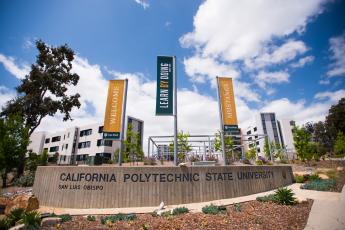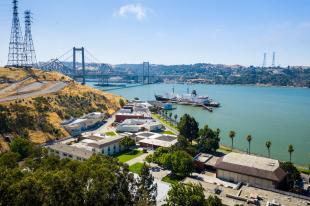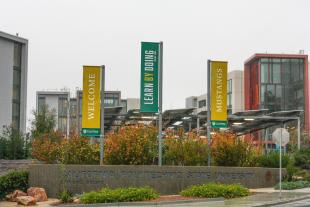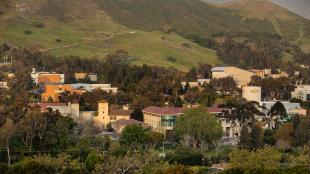President Armstrong: Addressing Concerns About Fall Quarter

This message originally appeared as an email to the campus community that was sent out on Tuesday, August 25.
Dear Campus Community,
I hope that all of you reading this are well and healthy and that you and your loved ones remain so. Please know that we care about each and every one of you, and we keep you and your interests in mind as we try to balance the various concerns around the start of Cal Poly's fall quarter on September 14.
At this time, a number of you have voiced questions or concerns around the university's plan to hold a small percentage of fall classes in person, and allow students to live on campus. There have also been concerns about students returning to off-campus communities.
First, thank you for raising these important questions - they touch on the health and safety of all of us and on Cal Poly's responsibility as a good neighbor and partner in the community. I especially want to thank the faculty, staff and students who have expressed the issues clearly and fairly and helped me understand that we need to explain our plans in more detail. I hear your concern and share your care for every member of our community.
While the note below is lengthy, it contains important information as there are a number of related issues to discuss, and they are complicated.
Ideals, Principles and Guidelines
Our planning has been guided by the advice of both on- and off-campus public health experts in our community, including our own faculty, and is grounded in their expertise as an overriding principle. Many experts believe we will be dealing with the virus for some time, despite the prospect of a vaccine. There remain questions about the availability and willingness of enough citizens to accept the vaccine and thus drive herd immunity to an appropriate level. Consequently, we have to make the best decisions we can, balancing the many competing and sometimes conflicting interests.
Because the coronavirus has become endemic in our communities, our approach has to be one of containment and risk minimization rather than attempting to prevent any transmission at all, which is no longer realistic. We know that every course of action has risk and that we will always be balancing interests and risks. We take very seriously the fact that any decision will have impacts on many, especially our students, faculty, and staff, and our neighbors in San Luis Obispo.
To help inform our decisions, we have carefully reviewed and evaluated numerous plans that have gone through several layers of analysis including: The CSU Chancellor's Office; the San Luis Obispo County Public Health Department; Cal Poly's Department of Emergency Management; our experts at Campus Health and Wellbeing; and other infectious disease experts and epidemiologists on the faculty and off campus. Our plans are also in compliance with, and in most cases exceed, the governor's guidance for higher education. We are proceeding cautiously and deliberately, with due deference to the experts and the evidence.
On-Campus Housing
On-campus housing and in-person classes are part of our DNA as a comprehensive, polytechnic university and are inextricably linked due to the nature of our Learn by Doing pedagogy and the fact that first-year students start in labs and work on projects in week one. We also know that our on-campus residential experience is particularly important for high-achieving students from low income groups - especially students in majors in the colleges of Science & Mathematics and Engineering.
Because of the hands-on nature of our Learn by Doing education, we, more than most universities, have to be disciplined and learn how to deal with the virus. We must balance the continued success of our students with mitigating risk associated with the pandemic.
We know the vast majority (thousands) of students are coming back to San Luis Obispo regardless of whether our classes are 100% virtual and/or whether our campus severely limits student housing. More than 90% of our students have permanent homes more than 100 miles from campus. The majority signed 12-month leases months ago (many pre-COVID). We know this from our student surveys conducted in June and again in August; from what we witnessed last spring as we transitioned to 100% virtual learning; and from the numbers of students who have already moved back to San Luis Obispo over the summer.
Out of an abundance of caution, and in consultation with health experts and Dr. Penny Borenstein, SLO County Public Health Director, we have decided to limit on campus housing to singles. As of today, we plan to host no more than 5,150 students (mostly students new to Cal Poly) in on-campus housing in accordance with the guidance issued by the state.
As first-year students learn their block schedules tomorrow, we are again asking students to defer housing if they do not have in-person classes and feel comfortable taking virtual classes at their permanent residence. We encourage students especially first-year, with in-person classes, visa, health, safety, economic or other reasons to maintain campus housing for the fall quarter. We will not honor deferment of freshman housing if the intent is to move into the neighborhoods in San Luis Obispo.
Also, based on an abundance of caution, and based on the strong recommendation of Dr. Penny Borenstein and our experts, we will require that all students living on campus present a negative test result for COVID-19 taken within the 72 hours prior to arriving on campus. We understand that logistics and other circumstances may make it difficult for a student to obtain a test within this time frame. In the event that you cannot obtain a test, students can still check in - we will work with students in these circumstances to obtain a test over a short interval. In addition, we strongly encourage all students not living on campus to test for COVID-19 before returning to the area. Additional details will be communicated by Student Affairs no later than tomorrow.
Campus Health & Wellbeing has developed the capacity to conduct more than 600 tests per day in our on-campus student health center, provided no delays in the reagent supply chain. That kind of large-scale (relative to our population), quick-turnaround testing, coupled with robust contact tracing and the ability to isolate students found to be contagious, are essential to preventing inevitable transmissions from becoming a local outbreak. We are confident that the university has the staff, the expertise and the equipment necessary to do that; every layer of oversight, including the county public health officer, agrees.
We have thought seriously about whether students returning to on-campus housing endangers them or others. It is true that congregate living facilities like residence halls pose a higher risk of transmission. It is also true that we can mitigate that increased risk so that it remains low. Our new testing requirement will only add to the mitigation of risk. We do so by having all students living in single rooms; through requiring use of Personal Protective Equipment (PPE) in public areas; and by prohibiting use of indoor group spaces. And the most important way that we can mitigate risk is by the constant education and modeling of appropriate use of PPE, hand washing, physical distancing, and so on.
Our consulting health experts do not believe having students living on campus endangers faculty or staff if appropriate protective measures are followed. The vast majority of faculty and staff are teaching and supporting students virtually and are at no additional risk. Those who have volunteered to teach in-person will be at minimal risk from having students living on campus due to the protective measures implemented in campus housing and face-to-face classes. Staff who interact directly with students or with high-student-use facilities like bathrooms, may face some additional risk, but the health experts advising us believe that risk can be mitigated through appropriate use of PPE and sanitation. Please note that our experts are clear: Wearing a mask is essential to lowering risk. Contracting the virus through surfaces has been demonstrated to be a low-likelihood mode of transmission of the virus.
In-Person Classes
Our plan is to offer roughly 12% of our 4,300 fall classes in-person - about 511 sections in all. Enrollment data suggest that fewer than 6,000 students will be taking at least one in-person class this fall. The classes being offered in person were identified by the faculty as being difficult or impossible to offer virtually - from labs to performance classes, milking cows to testing rocket designs. The faculty teaching these courses have volunteered to do so, presumably because they are confident they can teach these classes in a way that is safe for themselves, their students and any other campus community members who might be involved (lab technicians, for example). These are classes students need to make progress toward their degrees (of course we are accommodating students who aren't comfortable taking in-person classes, though that may take the form of taking classes out of sequence, substitutions and other work-arounds). We will not be offering virtual sections of in-person labs, projects or activities; however, we will accommodate students who need in-person classes but who opt not to take any course that is offered in-person.
Off-Campus Housing
For our friends and neighbors in San Luis Obispo, the biggest concern is likely having more students living in the community, especially those who may be returning to SLO from areas with higher rates of illness, and those who choose to participate in risky behaviors or group behaviors (i.e. parties). Our experts indicate that proper use of masks, distancing, hand washing, etc., will clearly mitigate the risk of having additional people in our community. The key is compliance with these precautions.
Every person has a responsibility to prevent the spread of coronavirus. That means wearing a face covering, practicing physical distancing and following all of the local, county and state guidelines, including the safety enhancement zone established by the city of San Luis Obispo. Cal Poly receives daily reports from the San Luis Obispo Police Department and will enforce violations of these orders via the student conduct process.
Let me be clear: Individuals or organizations that engage in behavior that compromises the health and safety of the Cal Poly community will be sanctioned, including possible suspension or expulsion from the university. Each student that chooses to come to San Luis Obispo this fall is committing to upholding these guidelines, without exception.
Live Town Hall
To help share more information and the rationale behind our plans for fall, we will host a live town-hall discussion at 4:30 pm, Thursday, August 27. The online event will feature a panel of epidemiologists and public health officers who have been advising Cal Poly and will provide an opportunity for the campus and broader community to ask questions related to fall. We invite students, faculty, staff, parents and the public to attend and to submit their questions in advance.
Resources
We want you to know that Cal Poly is here to support you. Counseling services are available for Cal Poly students 24 hours a day, seven days a week, by calling 805-756-2511. Please do not hesitate to contact them.
The Employee Assistance Program (EAP) provides confidential counseling services to all Cal Poly employees and their families. To speak with a counselor at any other time, please call their 24-hour support hotline at 800-367-7474. More information about EAP's confidential services is available at this website.
For additional support, please contact the Dean of Students office at 805-756-0327 or deanofstudents@calpoly.edu.
Conclusion
I know that I have not addressed every issue of concern, but I fear I have already taxed your patience with this lengthy note. I'll close with this thought: Part of the lifeblood of an institution of higher education is informed disagreement and debate. I acknowledge that people of good will may disagree about how to balance the relevant factors, and whether our balance is the right one. I am genuinely grateful to those who have expressed their concerns. Hopefully these explanations of our thinking and planning have addressed some concerns, though inevitably, I'm sure they have not resolved them all. I understand and appreciate that, and I look forward to continuing these important conversations. Similarly, we continue to monitor the situation, and to respond to changes and new information.
Sincerely,
Jeffrey D. Armstrong
President




